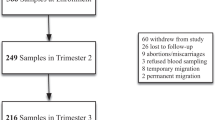Abstract
Objective: To determine the prevalence and predictors of anaemia in pregnancy in Singapore.
Design: Hospital based case controlled study.
Setting: National University Hospital, between January–December 1993.
Subjects: All women delivered at the National University Hospital, Singapore in 1993 had their haemoglobin estimated. If it was less than 11 gm/dl, blood was taken to establish the cause of anaemia. Data was also collected with regard to their antenatal progress, and factors predisposing to anaemia in pregnancy. Logistic regression, Chi-square test, Fischer's exact test, Mantel–Haenszel test were used to assess the relationships between categorical variables.
Results: The prevalence of anaemia at delivery was 15.3%. The most common cause of anaemia in pregnancy was due to iron deficiency (81.3%). The occurrence of anaemia in pregnancy is related to the socio-economic status of the women. Multiparous women of the lower socio-economic class who tend to book late in pregnancy were found to have the highest risk of anaemia.
Multivariate logistic regression analysis revealed iron prophylaxis, haemoglobin level at booking, race and previous history of anaemia in earlier pregnancy as important predictors of anaemia at delivery. The odds of anaemia for a woman not on therapy was about 11 times that of her counterpart on prophylactic iron therapy (95% CI 8.76–14.13). A 55% reduction in odds of anaemia was estimated per 1 gm% increase in haemoglobin level at booking. As compared to Chinese, Malays and Indians who experienced significant increase in odds of anaemia of 95% and 58% respectively. Further, a pregnant woman with a previous history of anaemia is 2.6 times as likely to be anaemic, as compared with one without history of anaemia.
Except for a higher incidence of preterm delivery, there was no other statistically increased risk of complications in the antepartum, intrapartum or postpartum periods. There was no difference in the incidence of antepartum haemorrhage/operative deliveries, postpartum haemorrhage, low birthweight, intrauterine growth retardation and neonatal outcome.
Conclusions: The study confirms that iron deficiency anaemia is the most common cause of anaemia in pregnancy and is a major health problem in developing and developed countries.
Sponsorship: This study was funded by a research grant from the National University of Singapore.
This is a preview of subscription content, access via your institution
Access options
Subscribe to this journal
Receive 12 print issues and online access
$259.00 per year
only $21.58 per issue
Buy this article
- Purchase on Springer Link
- Instant access to full article PDF
Prices may be subject to local taxes which are calculated during checkout
Similar content being viewed by others
Author information
Authors and Affiliations
Rights and permissions
About this article
Cite this article
Singh, K., Fong, Y. & Arulkumaran, S. Anaemia in pregnancy—a cross-sectional study in Singapore. Eur J Clin Nutr 52, 65–70 (1998). https://doi.org/10.1038/sj.ejcn.1600517
Received:
Revised:
Accepted:
Published:
Issue Date:
DOI: https://doi.org/10.1038/sj.ejcn.1600517
Keywords
This article is cited by
-
Beyond hemoglobin: uncovering iron deficiency and iron deficiency anemia using serum ferritin concentration among pregnant women in eastern Ethiopia: a community-based study
BMC Nutrition (2022)
-
Iron status and risk factors of iron deficiency among pregnant women in Singapore: a cross-sectional study
BMC Public Health (2019)
-
Racial variations in booking haemoglobin of primigravidae in Malaysia: a prospective study
BMC Research Notes (2013)
-
Role of Maternal Nutrition on Gestational Age and Birth Weight
National Academy Science Letters (2012)
-
Determinants of cognitive ability at 7 years: a longitudinal case–control study of children born small-for-gestational age at term
European Journal of Pediatrics (2009)



